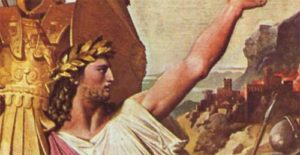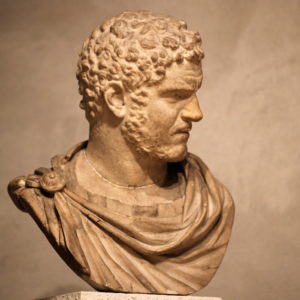Ancient Rome had many enemies. However, there were six who stood out amongst the rest as being extra vicious and violent. They were
1. Alaric, leader of the Visigoths – Enemies of Ancient Rome
He Created the Visigoths, a new ‘super-tribe’ which the Romans found impossible to defeat militarily. In 410 AD, he led the Visigoths to the first sack of Rome in 800 years. Alaric rose to power over the Goths in the mid 390s AD.

The Visigoths had been admitted into the empire in 376 AD. They defeated and killed emperor Valens at Hadrianople in 378 AD, and then made a treaty with the emperor Theodosius in 382 AD.
On Theodosius’ death in 394 AD, Alaric revolted in a bid to secure better terms for his followers. He attacked the cities of the east to force the eastern imperial authorities in Constantinople to offer concessions, which they did in 397 AD. In 399 AD, a change of regime led to their definitive removal, and in the 401-402 AD, he invaded Italy to try the same tactics – unsuccessfully – on the east.
Further barbarian invasions across the Rhine and Danube in 405-406 AD forced the effective ruler of the west, Stilicho ruling in the name of emperor Honorius, to seek out an alliance with Alaric. But Stilicho was toppled in 408 AD and Alaric invaded Italy again, demanding that all the promises should be fulfilled.
For over a year-and-a-half, from late 408 AD, Alaric’s Goths sat outside Rome to force Honorius and his advisors, safe in Ravenna in Northern Italy, to come to terms. He even raised his own Roman emperor from the Senate to apply more pressure.
No deal was forthcoming. Needing to satisfy his followers’ demands for plunder, he allowed them finally to sack the city on 24 August 410 – the first time this had happened for 800 years. Alaric died of disease early in 411 AD without extracting the deal he so craved.
2. Attila, King of the Huns, portrait from 1883 – Enemies of Ancient Rome
He led the Huns and their massed subject peoples in four massive assaults, attacking the east and west of the Roman empire twice each. Attila ruled the Hunnic Empire from 440 to 453 AD, first with his brother Bleda, then alone after he had Bleda murdered in Enemies of Ancient Rome. A first-hand account of Atilla by the Roman historian Priscus tells us that he was intelligent and extremely modest in his dress, although capable of violent outbursts of anger.

He ruled at the height of Hunnic power when the dominant Huns had gathered under their control many of the Roman Empire’s Germanic neighbors: Goths, Gepids, Rugi, Heruli, and others. Attila set his huge war machine to lose from the Great Hungarian Plain on two major campaigns against the Eastern Empire in 442 and 447 AD, taking many of the major cities of the Balkans and defeating the imperial armies in open battle.
The huge booty he extracted was supplemented by an annual subsidy from Constantinople of 2000lbs of gold. This wealth shows up in a string of fabulously rich burials of the Hunnic era, found in central Europe. In 451 and 452 AD, he turned westwards, attacking Gaul and Italy respectively. Again, these were not wars of conquest, but raids to extract wealth. Neither was completely successful.
Attila retreated from Gaul after defeat at the Catalaunian Plains and from Italy when his army was ravaged by disease. He died on the latest of many wedding nights in 453 AD, apparently from a hemorrhage.
On his death, his sons quarreled over succession and the Germanic subject peoples took the opportunity to reassert their independence. This destroyed Hunnic power and in 469 AD Attila’s only surviving son, Hernan, himself sought asylum in the eastern Empire.
3. Hannibal, Carthaginian general, and political leader -Enemies of Ancient Rome
Carthaginian general famed for bringing his army, including elephants, over the Alps. Inflicted three huge defeats on Roman armies, including the largest ever at the battle of Cannae in 216 BC Born in 247 BC, Hannibal became commander of the Carthaginian forces in Spain, in succession to his father Hamilcar in 221 BC.

At the time, Rome and Carthage were moving towards the outbreak of the second of the three so-called Punic wars (264-241 BC, 218-201 BC, and 149-146 BC) through which their conflict over the control of the western Mediterranean was eventually decided.
Hannibal took the war to Rome, and in May 218 BC conquered northern Spain before crossing the Alps in the autumn with 50,000 infantry, 9,000 cavalries and, famously, 37 elephants.
In Italy he fought a protracted campaign, winning three huge victories over the Roman armies sent against him: at Trebbia in December 218 BC, Late Trasimene in 217 BC (where 15,000 Romans were killed and another 10,000 captured) and, greatest of all, at Cannae in 216 BC.
Here, Hannibal showed the mastery of the combined use of infantry and cavalry for which he was famous to surround and annihilate a huge Roman army. Of perhaps 70,000 Romans, only 14,500 survived to be taken prisoner at the end of the day. It is the greatest number of casualties suffered in a single battle by any western army before or since.
In the long run, he never received enough reinforcements to threaten Rome itself despite his army surviving in Italy for over a decade. Roman victories elsewhere meant that peace was eventually made on Roman terms in 201 BC. Hannibal then became involved – eventually unsuccessfully – in internal Carthaginian politics and was driven into exile in 195 BC.
In 183 BC, he committed suicide by taking poison to prevent himself being handed over to the Romans.
4. Mithridates VI Eupator, King of Pontos
Mithradates VI Eupator Dionysius, to give him his full name, was the greatest king of the Pontic kingdom, which was centered on the southern shores of the Black Sea. He was Rome’s most dangerous Enemies in the first century BC, following the Roman defeat of Carthage in the second century BC.

Mithradates began by conquering the Crimea and the northern Euxine, securing almost complete control of the shores of the Black Sea and with it huge resources for his wars. At this point, Roman power was advancing into the eastern Mediterranean and a showdown was inevitable.
Mithradates prepared carefully, annexing Bithynia and Cappadocia to increase his power base. In his first Roman war (89-85 BC), he conquered all of Asia Minor, where he massacred all resident Romans and Italians.
He even took Greece before five Roman legions forced him back to Asia, where the subsequent peace confined him to his original Pontic kingdom. (To win Greek support against the ominous advance of Roman power, he had carefully echoed the ruling style and imagery of Alexander the Great.)
The second war (83-81 BC) was no more than a series of skirmishes, but full-scale conflict broke out again over Bithynia in 73 BC. The Romans were victorious and even drove him briefly into exile in Armenia. He was able to return to Pontus again in 68 BC, but was finally defeated by Pompey the Great and forced back into a Crimean redoubt.
There he was said to be planning a bizarrely ambitious invasion of Italy when his son overthrew him. Inured to poison by years of taking it, Mithradates was forced to ask a willing guard to run him through.
5. King Shapur I and the Roman emperor Valerian – Enemies of Ancient Rome
In 1936, investigators at Naqs-I Rustam, seven kilometers north of the old Persian capital at Persepolis, uncovered a monumental inscription recording the deeds of the Sasanian king of kings, Shapur I: the Res Gestae Divi Saporis.

He inherited power from his father Ardashir I (224-240 AD), who had turned the Sasanian family from regional magnates into a ruling dynasty. Shapur completed the process, setting loose in Iran and Iraq processes of economic and governmental development, which made the Persian empire more powerful than ever before.
The main object of Shapur’s reign and the achievement celebrated on the inscription was to throw back the might of the Roman empire. Ardashir had already captured from Rome the city of Hatra and in 244 AD the eastern emperor Gordian III advanced with a huge army to retake it.
Shapur defeated and killed Gordian at the Battle of Misiche. Buoyed up the tribute extracted from Gordian’s successor Philip, Shapur then occupied Armenia and devastated Syria, defeating Philip in turn and sacking the great city of Antioch, capital of the Roman east, in 252 AD.
In 260 AD, he won the third of his great victories over Rome, defeating and capturing emperor Valerian. A famous stone relief portrays Valerian kneeling in chains before him. When the Roman emperor died in captivity, Shapur had him skinned and preserved.
Shapur was famous for grandiose building and irrigation schemes, many of them using captured Roman manpower. He was never able to occupy Roman Syria permanently, but his reign turned Persia into a near eastern superpower.
6. Arminius, ruler of the Cheruscans – Enemies of Ancient Rome
When Roman power was advanced from the Rhine to the Elbe, Arminius had initially accepted the situation. He graduated to Roman citizenship – in those days a considerable honor – and a military command in the imperial auxiliaries. But by 9 AD, he was disgusted by what he saw as Roman oppression and secretly organized a revolt, which involved contingents from a large number of Germanic tribes.

Pretending friendship, he lured the Roman governor of Germany, Quinctilius Varus, with a huge force of three legions (c. 15,000 men) and a large number of auxiliaries into an ambush in the so-called Teutoburger Wald. Part of the battle site has recently been identified near Kalkriese, about 16 km north of Osnabruck, in northern Germany.
The Roman army found itself trapped between wooded hills and deep marshes. In a three-day running battle, it was crushed. Varus himself committed suicide as his command was massacred around him, with few escaping. The emperor Augustus’s dying words were: ‘Varus, give me back my legions.’
Even after this huge victory, Arminius won only temporary allegiance from his people. In the face of the Roman counterattack and his own aspirations to kingship, support melted away from him and towards his uncle Inguiomerus. First, his family was taken captive and then he himself was eventually killed by his own people.
In the modern era, he has turned anachronistically into a symbol of triumphant German nationalism, but the monument erected to him at Detmold in 1875 is 70 km south of the real battlefield.




